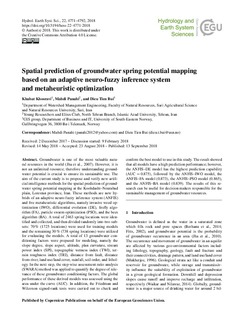| dc.description.abstract | Groundwater is one of the most valuable natural resources in the world (Jha et al., 2007). However, it is not an unlimited resource; therefore understanding groundwater potential is crucial to ensure its sustainable use. The aim of the current study is to propose and verify new artificial intelligence methods for the spatial prediction of groundwater spring potential mapping at the Koohdasht–Nourabad plain, Lorestan province, Iran. These methods are new hybrids of an adaptive neuro-fuzzy inference system (ANFIS) and five metaheuristic algorithms, namely invasive weed optimization (IWO), differential evolution (DE), firefly algorithm (FA), particle swarm optimization (PSO), and the bees algorithm (BA). A total of 2463 spring locations were identified and collected, and then divided randomly into two subsets: 70 % (1725 locations) were used for training models and the remaining 30 % (738 spring locations) were utilized for evaluating the models. A total of 13 groundwater conditioning factors were prepared for modeling, namely the slope degree, slope aspect, altitude, plan curvature, stream power index (SPI), topographic wetness index (TWI), terrain roughness index (TRI), distance from fault, distance from river, land use/land cover, rainfall, soil order, and lithology. In the next step, the step-wise assessment ratio analysis (SWARA) method was applied to quantify the degree of relevance of these groundwater conditioning factors. The global performance of these derived models was assessed using the area under the curve (AUC). In addition, the Friedman and Wilcoxon signed-rank tests were carried out to check and confirm the best model to use in this study. The result showed that all models have a high prediction performance; however, the ANFIS–DE model has the highest prediction capability (AUC = 0.875), followed by the ANFIS–IWO model, the ANFIS–FA model (0.873), the ANFIS–PSO model (0.865), and the ANFIS–BA model (0.839). The results of this research can be useful for decision makers responsible for the sustainable management of groundwater resources. | nb_NO |

